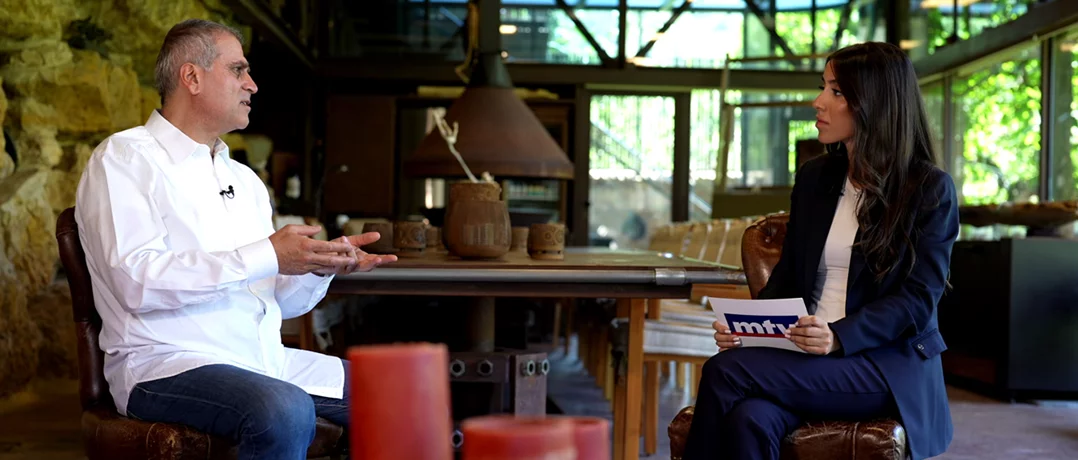World-renowned artist Rudy Rahme talks about creation, the spirit of the country and putting together an art collection that tells the story of Lebanon.
A country's essence

The sculptor does not greet one with words. He just gestured toward the sculpture in front of him and placed his hand on the grain as if introducing us to an old friend. His workshop has now been turned into a museum exhibiting a lifetime of creation.
He sits upright, deliberate but at ease, his movements measured, his gaze steady. In the hills of Zouk, a town north of Beirut, far from the noise but close to the marrow of the land, internationally acclaimed sculptor Rudy Rahme, known for his cedar wood artwork, introduces himself with his poetry.
“I am the child of a place that is an impossible fusion,” he recites. “A mix between prayer and science, between stillness and sudden bursts of wild energy.”
“Rudy Rahme is a mischief, between primal thought and visionary thought, between the raw and the refined,” he adds with a smile.
Rahme’s latest project is to curate an art collection to narrate the modern history of Lebanon and exhibit the works in the Lebanese Presidential Palace, something the institution hasn’t seen in the past decades. The journey, he says, started with a commission to create a sculpture for the Palace in Baabda. But he saw a need for more.
“When I stepped inside,” he says, “I felt the walls were a bit empty. As if they had lost their voice. They need to breathe again, to be filled with color, with memory, with presence.”
The artist says he believes the Baabda Palace, the residence of the Lebanese heads of State, should be able to tell the story of the country’s spirit and diversity. According to Rahme, the goal is to build a visual narrative of Lebanon’s identity, one that balances heritage with contemporary expression and contributes to the preservation of national memory. He says he plans to gather works by Lebanese artists to show the diverse Lebanese spirit in the very place that is designed to represent it.
The cedar sculptor
Born in 1967 in the mountain village of Bsharri, North Lebanon, Rahme graduated from the Lebanese Academy of Fine Arts (ALBA). He then specialized in fresco and sculpture in Italy at the Spinelli Academy in Florence. He continued his training in Paris at the Coubertin Foundry.
Sculptor, painter, poet, Rahme explains that he sees no boundary between disciplines. For him, they are intertwined expressions of the same soul, an inheritance he shares with his spiritual muse, Gibran Khalil Gibran. Rahme’s work has been showcased across major cultural capitals, from the Carrousel du Louvre in Paris to the Top Marques Art Fair in Monaco, the Affordable Art Fair in Singapore, World Art Dubai, and the Miami River Art Fair. His 29-meter “Cèdre de Lamartine,” carved into a living cedar in the mountains of Lebanon, earned him a place in the Guinness World Records and helped cement his reputation internationally. So too did his sculpture Vous êtes un arbre, permanently installed at the entrance of Les Franciscaines museum in Deauville, France. His iconic “Walking Rock” series - stone sculptures that appear to move mid-stride - was first developed in Florence as part of his patented technique blending motion with material, a metaphor for migration, endurance, and transformation.
Cedar and marble
In his latest work, Rahme says he showed Lebanese President Joseph Aoun what the artist thought was the expression of Lebanese modern history: the weariness of the Lebanese.
“How we have grown tired, and yet, how we have become part of the land itself, part of the very cedar,” the artist explained. At first glance, it is an abstract rendering of a windswept cedar tree made of marble powder. But at a closer look, human silhouettes begin to emerge from the flowing stone. Arms stretched, bodies curved, as if both holding the cedar up and being shaped by it. The sculptor says it’s a metaphor: a people rooted in their land, and a land molded by its people.
“Our ancestors, the poets, the artists, they taught us to love this land more than anything,” Rahme explains. “Lebanon is engraved in us, sometimes without us even realizing why. It is a country that insists on being expressed, a place that lives inside you, no matter where you go.”
The artist explains that the material chosen for a sculpture also tells its part of the story. “With stone, you feel a revolution rising inside you, something heavy, something urgent, demanding to break free. It is a material that invites eruption,” he pointed out.
What Rahme says fascinates him most is the paradox at the heart of creation: that from hardness, softness can be born, and from softness, hardness. “Even the smoothest pebble,” he says, “can become something sharp. The true artist is the one who knows how to hold both.”



.webp)